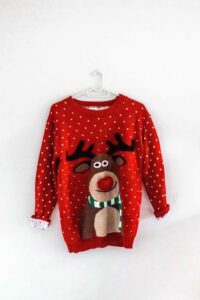How to prepare for the Christmas sales period
Blog 5 mins
Topics

It may be Summer but retailers are turning their heads to Christmas and their peak sales period where they can expect sales to increase considerably. Last year, sales rose by 6.9% in December against an increase of 2.1% in December 2021, according to the British Retail Consortium.
Preparing early for sales peaks can put retailers at a considerable advantage. Not only can they plan for the increase in demand of certain popular goods and ensure products are at the right destination to meet consumer demand, but they can also ease pressure on product classification teams who each year are faced with mounting numbers of products to classify and shepherd compliantly through complex customs procedures.
Each year our TariffTel solution, which automatically classifies products assigning the correct HS codes to a range of products from homewares, to fashion and food, supports retailers such as M&S, Primark and ASDA in being prepared for Christmas and Black Friday demand. Our experienced team ensures that any questions over classifications are resolved quickly by taking the time to understand the more complex classifications. Here, Daniel Mcmenemy, who works within our TariffTel solution answers some common questions about how businesses can prepare now to capitalise on the Christmas rush.
Q. What are the common problems retailers face around classification during busy sales periods
Classification is a complex area, often requiring specialized knowledge and expertise, and retailers can face a variety of challenges during busy sales periods.
For example, during these periods retailers often offer a wide range of products, or variations of existing ranges, and this can make classification challenging, particularly if the products lack key pieces of information required to classify correctly, such as the construction and material breakdown.
Furthermore, working from spreadsheets, trying to hold a great deal of information across multiple ranges, from various suppliers, which feed into different departments is an extremely time-consuming manual process.
Alongside this, the HS Tariff is frequently updated, introducing new codes, removing the old, and updating interpretation. Meaning that a classification which was accurate last year, may now be incorrect.
Q. How can these problems be avoided?
Using an automated classification system such as TariffTel can help alleviate these problems. TariffTel acts as a centralised hub in which all product data is conveniently held, and the system allows internal communication between retailer and suppliers. The TariffTel team also handles the maintenance of your commodity codes, paying close attention to any Tariff Code changes, or changes to the interpretation of the Tariff, and making sure the system remains up-to-date and accurate.
For example, when classifying plush stuffed non-human toys for Christmas, it is important to understand what the Tariff considers to be ‘stuffed’. Taking a textile cuddly animal toy as an example, this could fall under two different classifications, with differing duty rates. Were it fully stuffed with synthetic fibres like arms, legs, body and head, it would meet the definition of ‘stuffed’ proffering a duty rate of 4%.
However, if the toy had a plastic skeletal structure, with a plush textile cover, it would not meet this definition and instead proffer a 0% duty rate.
Now, if the toy had a stuffed head, arms and legs, but an electronic voice box in the centre, according to the European Explanatory Notes, this would be considered a stuffed toy, as the stuffed elements retain the essential character of a stuffed toy.
The TariffTel team monitor these interpretive updates and adjust the system accordingly, making it easy to get the right code for your product.

Q. Which common Christmas products can cause problems when classifying?
There are many Christmas products which can be difficult to classify accurately, particularly when trying to understand what can be classified as a ‘Christmas Article’ of 9505 10 and what is not permitted under this heading.
Christmas Articles of this heading are restricted in what they are allowed to portray, for example, a decorative representation of the Nativity, can be classified within this heading, whereas a decorative snowman, would not be classifiable here. Decorative ‘Christmas Articles’ designed to be placed around the home during the holiday, must be recognised as holiday articles due to longstanding national traditions, as opposed to simply being related to the winter season.
However, this is not the case with hanging ornaments of non-durable, lightweight materials, used to decorate a Christmas Tree, as these products do not need to have any connection to the holiday season. For example, a hanging snowman would be classifiable as a ‘Christmas Article’ of 9505 10, whereas a decorative standing snowman would not.
More technologically advanced Christmas products offer a different level of complexity. Drones were introduced into the Tariff in the 2022 update, and we now need to consider whether a drone is a toy, or if it is an unmanned aircraft. A toy drone has limitations on what it is capable of, such as, limited flight height, distance, flying time and speed, and must feature easy-to-use remote controls. Furthermore, it may not have any sophisticated technological components, such as GPS, nocturnal visibility, or night flying requirements.


Q. Are there any additional things to think about when exporting or importing products to Europe or the US?
There is often a difference in the level of complexity between the EU and the US, in regards to certain products. Using garments as an example, the difference between classifying a knitted Christmas jumper in the EU tariff vs a knitted Christmas sweater for the US is surprisingly large.
For the EU, a Christmas jumper falling under heading 6110 is a relatively simple classification where we would ask; what is the material breakdown? Is the garment for men, women or unisex? Is it hand-made or not hand-made? And – for certain materials – is the garment a lightweight fine knit roll, polo or turtleneck?
For the US, we would need answers to most of the same questions, as well as further information. The HTSUS holds provision, at a statistical level, for ‘Sweaters’ which are required to have a stitch count of 9 or fewer stitches per 2 centimetres measured on the outer surface of the fabric. There is also provision for ‘Sweatshirts’ which are required to have a snug-fitting bottom and cuff, no full frontal opening, and be significantly napped on the inside.
Alongside this, we have been calling the EU Christmas garment a ‘jumper’, whereas in the HTSUS a ‘jumper’ is actually defined as a garment similar to, what we in the UK, would know as a pinafore dress. As you can see the difference between the amount of work required to classify this particular garment at an EU or US level differs significantly.

Q. What are your top 3 tips for ensuring retailers have the right stock on shelves this Christmas?
- Be proactive about classifying products and don’t approach it as just a tick box exercise in ensuring you have the right documentation, classification is crucial and getting it right initially will save time and money down the road.
- Invest in technology to support you with the continual changes to HS codes, as well as the interpretation of the Tariff, to ensure you are up to date and compliant.
- Educate yourself and your team and when in doubt source help from expert teams – classification is a complex field and often requires debate and research to determine the correct code. Involving specialists who understand the interpretive rules of classification and who know the tariff can help save on non-compliance fees and shipment delays.
Other useful resources
Team spotlight – Elizabeth Davies, Customs Systems Manager
This month it's our Customs System's Manager, Elizabeth Davies, taking a turn in the hot s...
How TariffTel transforms your approach to customs classification
International trade today is a dynamic and evolving world to operate in. Whichever sector ...
How technology integration is transforming customs classification
In today's rapidly evolving global marketplace, the successful adoption and integration of...



